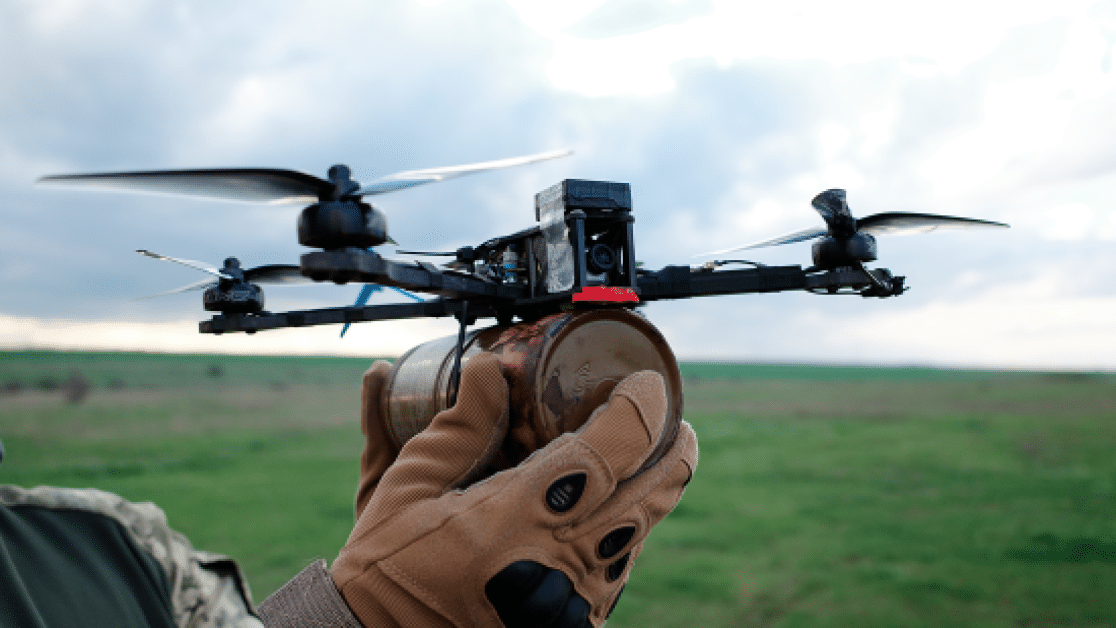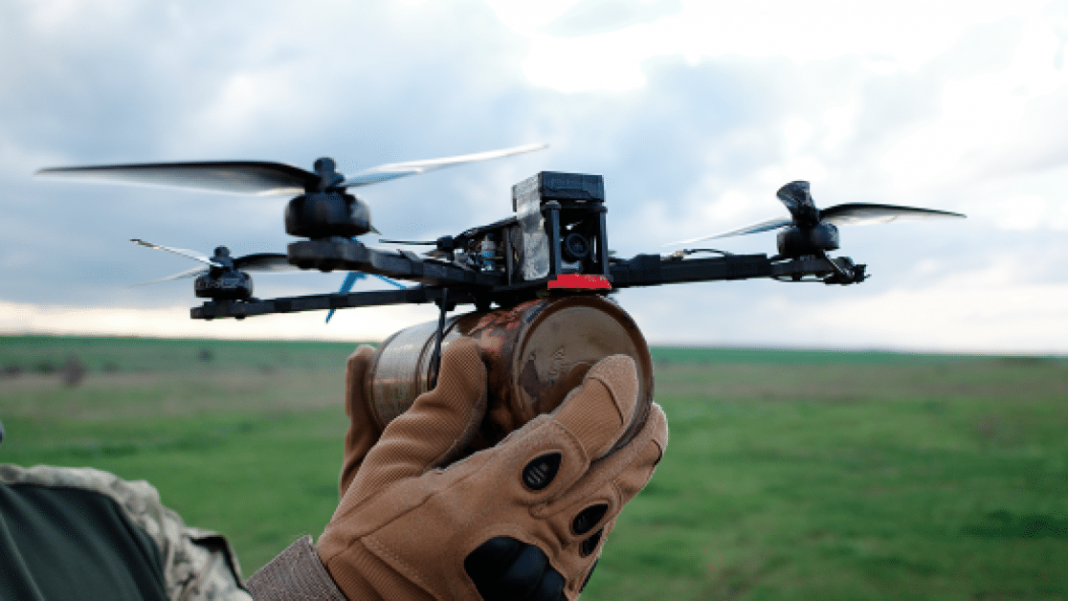
Thursday, August 10, 2023 – 12:16 (EEST) Section: Analysis & Opinion, Latest news, Military
Volunteers assemble and send drones to the front lines capable of carrying up to 1.5 kg of explosives. Such quadcopters can destroy light enemy vehicles and personnel without endangering Ukrainian soldiers.
These drones are made from Chinese spare parts. The cost of each “bird” is approximately $400. Volunteers claim that even a student with soldering skills can assemble such a drone after a short training period.
Lethal “birds”
Military personnel are increasingly using FPV drones on the front lines, prompting many locations to produce and teach the assembly and operation of these devices. Control of these drones is achieved through specialized goggles that provide a first-person view, as indicated by the abbreviation FPV: First Person View.
In the spring, a volunteer team called Port Frankivsk began producing drones of this kind. Before this, its members were purchasing drones, tactical ammunition, and other items for the front lines.
“At some point, we started receiving a significant number of requests to acquire FPV drones. The Ukrainian market didn’t have enough drones to meet even a quarter of the fighters’ needs, so we decided to try assembling them ourselves,” says Roman Kapiy, co-founder of the Port Frankivsk foundation.
None of the team members had experience in drone assembly. The Port Frankivsk volunteer initiative includes entrepreneurs, cultural figures, and IT specialists. Before the war, they were all part of the city’s cultural community to varying degrees. Launching the process of assembling the first batch of drones was aided by programmer Volodymyr Kaban. He also lacked such experience but understood how everything should work.
To procure components for the first batch of drones, the volunteers invested their own funds along with contributions from patrons. They didn’t publicize their initiative until the successful testing of 20 prototypes. In May, when the manufactured devices were sent to the front lines and tested in combat conditions, the foundation announced a fundraising campaign for a larger batch — 70 combat FPV drones and seven signal repeaters.
A sport FPV drone is more maneuverable than traditional “wedding mavics”(quadcopters) It can’t hover in the air and moves at high speeds, making it much harder to detect and shoot down.
“The drone can carry up to one and a half kilograms of explosives and fly up to 8 kilometers without a signal repeater. With its useful payload, the drone reaches speeds of up to 60 kilometers per hour,” notes a volunteer.
Components for such drones can be freely purchased on the market. These are not military technologies; FPV drones are used for entertainment in civilian life, such as in sports racing. They can fly in terrain with challenging obstacles, navigate narrow spaces, and move through abandoned buildings. On the front lines, these drones precisely target enemy bunkers, tank hatches, vehicles, and trucks.
Prices for FPV drones depend on their technical specifications. The cost of producing a combat drone from Chinese modules is around $400. A ready-made drone in Ukraine costs significantly more. Volunteers primarily purchase drone components with funds from patrons who finance large order batches for the military, usually more than 50 units. Among them are owners of IT companies, local builders, and entrepreneurs.
“It’s not exactly manufacturing; it’s assembly. There’s no element of technological innovation here. We order all the modules from China, and even a high school student can assemble a drone after a short training,” explains Kapiy.
According to him, other organizations that manufacture drones for the front lines also follow the approach of assembling large modules. The largest of these are Eskadron and Vyriy.
“We order the basic version of the Chinese drone without modules that don’t suit our needs. We install a powerful video transmitter, which determines the range of drone control, an antenna, remove the GPS, reflash it, and the drone becomes ready for use in non-protocol conditions,” explains the volunteer.
In Port Frankivsk, drones are assembled by groups of four or five people. Everything is built on a volunteer basis, which allows them to produce ready-made drones at the cost of the components.
“We can manufacture 15 drones per day. There are manufacturers with much larger capacities. Production is dispersed across various apartments, offices, and small warehouses,” says the co-founder of the volunteer initiative.
Lyuba Shypovych, the founder of the Dignitas foundation, which supports Ukrainian drone manufacturers, states that many IT companies have such production facilities within their offices.
“They have the funds to buy components and have staff with engineering education. Learning to assemble them isn’t difficult — there are many videos available on the internet. Additionally, almost every flight school has an engineering program where they teach drone assembly,” she says.
According to Shypovych, a widespread phenomenon along the front line are “home workshops” where military personnel assemble drones.
“We bring manufacturers together, organize conferences and demo days for them. Estimates suggest that the current production volume of such drones in Ukraine is around 10,000 to 12,000 per month,” adds the volunteer.
See also: Drone warfare: what kind of kamikaze drones are used by Ukraine and Russia?
Volunteers hand over the drones to pilots. The “birds” are sent via the Nova Poshta delivery service to towns near the front lines. There, the military personnel attach explosives to them using makeshift tools, and the kamikaze drones are ready.
“Usually, around 12 hours after receiving them, they send us videos of how they performed,” notes Roman Kapiy.
Logistics from China and competition with Russians
According to volunteers, there is no alternative to Chinese components in terms of the price-to-quality ratio. Some distributors in the EU have contracts with Chinese manufacturers, making it easier to buy from them than from China, but it ends up being more expensive.
However, Chinese factories also sell parts to Russians. Manufacturers often prioritize large orders from Russia, ignoring small customers. As a result, for volunteers, procurement becomes a hunt for the necessary components.
“When it comes to large batches of components, it’s a competition with Russians. The same factory produces batches for both Russians and Ukrainians. On one batch, they write ‘Death to Ukrainians,’ and on another, ‘Fuck you Putin.’ However, Russians can throw state money into it and buy drones by tens and hundreds of thousands, while small Ukrainian manufacturers can’t do that,” notes the founder of the Dignitas foundation.
Kapiy explains that at one point, Russia contracted many video transmitters with frequencies of 1.2 GHz and 1.3 GHz, which are used in the production of kamikaze drones. Consequently, these components are harder for Ukrainians to find now.
When ordering parts from China, small manufacturers have to pay customs duties and VAT. This causes the cost of some components to increase by at least two times.
“China doesn’t directly supply anything to Ukraine. It orders parts in Poland, and pays customs duties there. Then it sends them to Ukraine and pays customs duties again,” explains Shypovych.
In 2023, the Verkhovna Rada (Ukrainian Parliament) exempted unmanned aerial vehicle (UAV) parts from VAT and import duties. However, this exemption is often unavailable for most small manufacturers because they are not registered as UAV producers.
“The exemption only applies to companies that work with China. Even distributor companies like Rozetka, which also started importing parts from China, don’t have the exemption,” says the founder of the Dignitas foundation.
Originally posted by Volodymyr Ryhlitsky on Economichna Pravda, translated and edited by the UaPosition – Ukrainian news and analytics website
See also: FPV drones: a new threat to the Ukrainian military. How to respond







